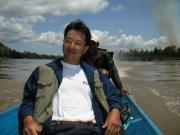Research Experience
-
2017.04-Now
Waseda University Faculty of Human Sciences Professor
-
2023.04-2024.03
University of Tsukuba Institute for Comparative Research in Human and Social Sciences (ICR) Visiting Researcher
-
2020.09-2022.09
Waseda University Graduate School of Human Sciences Dean
-
2020.09-2022.09
Waseda University Faculty of Human Sciences Deputy Dean for International Affairs
-
2004.08-2017.03
The University of Tokyo Graduate School of Agricultural and Life Sciences Professor
-
1996.04-2004.08
The University of Tokyo Graduate School of Agricultural and Life Sciences Associate Professor
-
1995.11-1996.03
The University of Tokyo Faculty of Agriculture Associate Professor
-
1991.04-1995.10
The University of Tokyo Faculty of Agriculture Assistant Professor
-
1990.01-1991.03
Forestry and Forest Products Research Institute, Japan Forest Management Division Research staff
-
1990.01-1991.03
Forestry and Forest Products Research Institute, Japan Forest Management Division Research staff
-
1987.04-1989.12
Tropical Forest Research Center, Indonesian Ministry of Education and Culture (Samarinda, Province of East Kalimantan) Research staff (JICA long-term expert)
-
1983.04-1987.04
Forestry and Forest Products Research Institute, Japan Forest Management Division Research staff
-
1983.04-1987.04
Forestry and Forest Products Research Institute, Japan Forest Management Division Research staff


Click to view the Scopus page. The data was downloaded from Scopus API in January 05, 2026, via http://api.elsevier.com and http://www.scopus.com .